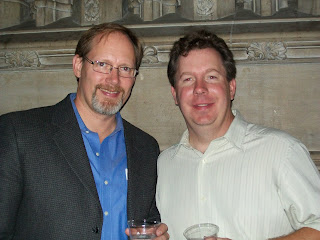
By the time the second act ends, you will be longing to see comeuppance reign down on John Rutherford Sr., the tyrannical patriarch in the revival of Githa Sowerby’s Rutherford & Son, which opened last night in a 100th anniversary celebration at the Mint Theater Company. Such is Sowerby’s skill as a playwright that you will not see the ending coming. And you will leave this two-and-a-half-hour show savoring the delights of a thoroughly great production.
Rutherford, played with chilling force by Robert Hogan (in photo), dominates his household and his glassworks factory in the industrial north of England with not a shred of compassion. So thorough is his hold over his three adult children that his only daughter, Janet (Sara Surrey, in photo), 36-years-old and unmarried, brings him his slippers each evening and removes his boots. Son John (Eli James), who works with him at the factory, and his other son, Richard (James Patrick Nelson), are weak, spineless creatures who cower under their father’s rule.
Director Richard Corley allows this tension to permeate the stage and seep into the audience. Even when the elder Rutherford isn’t seen, his presence is felt in the family’s gracious Victorian living room (excellent set by Vicki R. Davis). Since his wife died years before, his sister, Ann (Sandra Shipley), has taken on the woman of the house role, but only in a small way. Even she plays a subservient role to this man who is used to getting his own way and will tolerate nothing less.
The suspense of the plot hinges on whether John junior will be able to break free and enjoy an independent life with his working class wife, Mary (Allison McLemore), and their infant son by selling a new metal formula he has discovered. The personal metal of all of the characters will be tested.
Rutherford & Son is the latest example of how wonderfully this theater company, under artistic director Jonathan Bank, carries out its mission of resurrecting forgotten and neglected plays and restoring them to mint condition. This company not only offers first-rate productions, but the handouts and program notes enrich the experience with fascinating background information about the plays and playwrights.
We learn that Rutherford & Son was originally scheduled for only four performances when it opened at London’s Royal Court Theatre on Jan. 31, 1912, but the critical response was so enthusiastic it quickly transferred to the West End.
“One of the very best, strongest, deftest, and altogether most masterly family dramas that we have had for a long time from any one, however famous,” wrote one London critic.
The New York premiere later that year equally impressed American critics: “A play that carries conviction in every line — that leaves no doubt that it was written out of a fullness of knowledge of the life and people with which it deals,” wrote The New York Times.
That reaction proved to be timeless.
“Sowerby knew what she was talking about,” wrote Lyn Gardner in The Guardian of a 2009 London revival. “The amazing thing is that she did it so blatantly and with such flair almost 100 years ago, when women were seen but seldom heard on British stages.”
The fact that she was a woman threw the original critics for a loop. Surprised that such a play of such depth and stagecraft could be penned by a first-time playwright, the London Times predicted a future “full of promise” for this talented writer, known at that point only as “K.G. Sowerby.”
When “K.G.” was revealed to stand for Katherine Githa, critics were gob smacked. The playwright, whom one critic referred to as a “girl-dramatist,” made headlines in New York as well as London and her work was compared to that of Ibsen.
The Times of London observed: “She is the last person in the world one would expect to find as the author of so grim, powerful and closely thought-out drama of business. Instead of looking as if she wrote this play, she is a young, pretty, fair-haired girl, refined of speech and dainty in dress, who seems far better suited to a drawing room than to the dramatist’s work room.”
She was portrayed as an English rose who’d stumbled into play writing, and, being a private person who avoided interviews, she did little to correct that impression.
In the midst of such triumph, she became engaged to John Kaye Kendall, a poet and dramatist, after knowing him for only three weeks and married him two months later.
She remained a private person, and even burned her personal papers shortly before her death in 1970. By that time, both her and her work had been forgotten. None of her plays after Rutherford & Son had achieved acclaim and even Rutherford disappeared from the repertory.
When the National Theatre revived Rutherford & Son in 1994, inspiring new interest in Githa, her life remained a mystery. With the publication of Looking for Githa by Patricia Riley two years ago, concrete details of Githa’s life and family history finally emerged. The Mint’s program includes an essay by Riley, whose biography was greatly helped by memories shared by Githa’s daughter, Joan. Riley learned that the ruthless industrialist Rutherford was based on Sowerby’s grandfather who owned a glassworks factory. She writes that Githa had been successful as a children’s book author before turning to play writing. She penned other plays, but Rutherford was her most successful.
“She died in 1970, aged 93, believing that her work had been forgotten and, wrongly, that her family had no interest in her achievement,” Riley writes.
Fortunately that didn't prove to be true, and thanks to the Mint another great play and playwright have been brought back to life for New York audiences. This excellent production continues through April 1. For more information, visit minttheater.org.

















